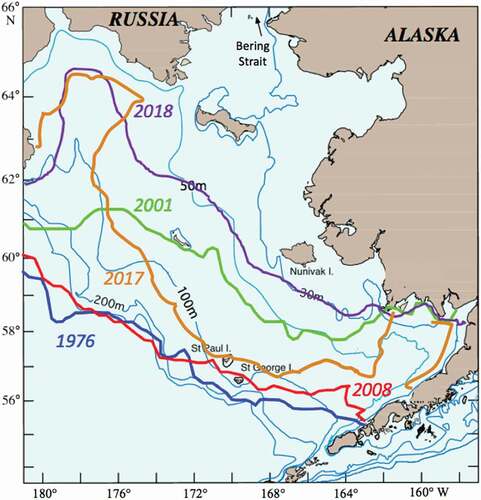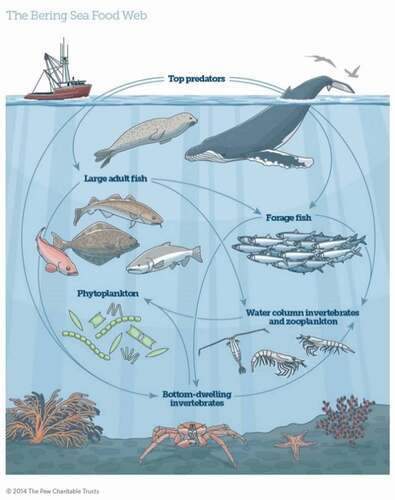THE ISSUE
The Bering Sea supports one of the largest, most profitable food fisheries in the world. Commercial fisheries are the largest private-sector employer in Alaska. The extent, duration, and timing of sea ice advance and retreat are changing dramatically in the warming Arctic, and this accelerated transformation affects food webs on which commercially important fisheries depend. When sea ice is lacking, there are major shifts in where commercially important fish are found and in the food webs on which they depend.
WHY IT MATTERS
Fishing is the core economy for much of coastal Alaska, where fish harvesting and processing often provide the only significant opportunities for private-sector employment and where fisheries support businesses that provide property and sales tax as the largest source of local government revenues.Citation1 Nearly two million metric tons of Pacific cod, walleye pollock, and salmon, as well as a variety of other fin fish and crab, are harvested annually from the Bering Sea, accounting for over half of total U.S. harvest volume and almost a third of U.S. harvest value.Citation2
Changes in fish stock abundance and distribution impact the harvests, as well as the economies, of communities participating in the harvests and processing. Understanding and predicting changes in fish distribution and abundance enables decision makers to adapt fisheries management strategies such as adjusting the total allowable catch of a given species to reflect its predicted future abundance.
STATE OF KNOWLEDGE
Most Bering Sea fisheries production occurs on the southeastern shelf. Until recent years, the eastern shelf has been reliably covered by sea ice during the cold season ().Citation3 Sea ice over the southeastern shelf affects fish and fisheries in many ways. Ice cover thwarts fishing activity from large areas of the shelf in winter. The cold (<2°C) water that forms on the shelf where ice has lingered and melted deters predatory adult arrowtooth flounder.Citation4, Citation5 Hence, it provides a potential refuge for juvenile walleye pollock and other forage fish more resistant to the cold.
Figure 1. Spring ice extent in the Bering Sea varies greatly from year to year. Years 2001 and 2018 had the least ice, and years 1976 and 2008 had the most. Figure courtesy of Phyllis Stabeno, NOAA, Pacific Marine Environmental Laboratory.

The sea ice also supports ice algae on its underside. These algae are an important food for egg production by zooplankton in winter and for the growth of young zooplankton in spring.Citation4 These zooplankton, in turn, are an important food for the juveniles of commercially important fish.Citation4 If the ice melts too early, there is not sufficient ice algae to feed the zooplankton. The juveniles of commercially important fish species then have too few large zooplankton to consume for nourishment. Recent research has shown strong correlations between the abundance of zooplankton in summer and the survival of harvestable, young-of-the-year walleye pollock and Pacific cod. Thus, sea ice cover in spring is linked, through ice algae and zooplankton, to the productivity of eastern Bering Sea pollock fisheries.
WHERE THE SCIENCE IS HEADED
As the eastern Bering Sea warms, sea ice is declining.Citation3 The production of pollock, cod, and possibly other species is likely to diminish (). Many temperate species will move northward, as they did during the reduced sea ice cover in 2018, and become less accessible to fisheries based in the southern Bering Sea.5,Citation6 However, the ability of fish species of southern origin to survive in the northernmost Bering Sea and Arctic Ocean may be limited. In winter, the cold, salty brine that results from sea ice formation creates bottom waters over the northern shelf that are too cold for most fish species to survive.
Figure 2. Commercial fish species found in the Bering Sea include six species of Pacific salmon, Alaska pollock, Pacific cod, Pacific halibut, yellowfin sole, Pacific ocean perch, and sablefish. Red king crab are also among the types of shellfish found. A healthy, balanced food web contributes to their overall number and distribution throughout the area. Copyright The Pew Charitable Trust, with permission. http://www.pewtrusts.org/-/media/assets/2014/10/ecosystem-based-fishery-management-in-the-bering-sea.pdf

Climate and atmospheric scientists are working to predict the future climate of the eastern Bering Sea.Citation6 For commercially important fishes, oceanographers are developing models that will permit predictions of the number of young fish that will survive to harvestable size based on future climate conditions. At present, models are relatively skillful in predicting the survivability of young-of-the-year pollock based on the amount of large, lipid-rich zooplankton over the southern Bering Sea shelf. The ability to predict the abundance of these zooplankton based on physical attributes of the ocean is improving, because understanding mechanisms affecting their productivity is critical for predicting the effects of sea ice loss on commercially important fisheries, such as that for walleye pollock.
Supplemental Material
Download MS Word (191.7 KB)Supplementary material
Supplemental material for this article can be accessed on the publisher’s website.
Key references
- http://www.akrdc.org/fisheries
- http://labor.alaska.gov/trends/nov17.pdf
- Thoman, R.L. Jr., U.S. Bhatt, P.A. Bieniek, S.L. Danielson, and Z. Labe. 2020. Record low Bering Sea ice extent in 2018: context, impacts and an assessment of the role of anthropogenic climate change. [in “Explaining Extremes of 2018 from a Climate Perspective”]. Bulletin of the American Meteorological Society 101 (1), S17–S22, doi:https://doi.org/10.1175/BAMS-D-19-0175.1.
- Hunt, G.L., Jr., E. M Yasumiishi, L.B. Eisner, P.J. Stabeno, and M.B. Decker. 2020. Climate warming and the loss of sea ice: the impact of sea-ice variability on the southeastern Bering Sea ecosystem. ICES Journal of Marine Science, doi:https://doi.org/10.1093/icesjms/fsaa2067.
- Stevenson, D.E., and R.R. Lauth. 2019. Bottom trawl surveys in the northern Bering Sea indicate recent shifts in the distribution of marine species. Polar Biology 42: 407–421.
- Hermann, A.J., G.A Gibson, W. Cheng, et al. 2019. Projected biophysical conditions of the Bering Sea to 2100 under multiple emission scenarios. ICES Journal of Marine Science 76: 1280–1304.
